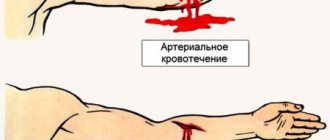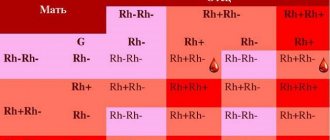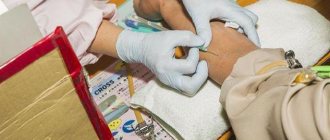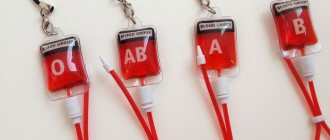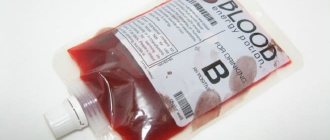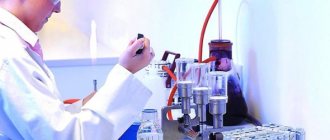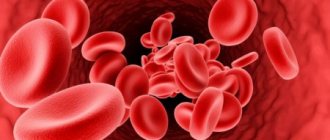The third blood group is considered rare - it is found in only 15% of people inhabiting the Earth. According to some reports, we owe its appearance to the nomadic Mongoloids. The age of the group is more than 17 thousand years. The third negative is, accordingly, even less common. It is more common among people living in Asian countries, the Middle East, and Africa. Interestingly, some researchers say that it determines a person’s character. So let's get to know the third negative category in detail!
General information
Blood is a biological fluid that circulates throughout the body of every person in a volume of 5-6 liters (approximately 7% of body weight). Researcher K. Landsteiner discovered four of its categories:
- The first one is O.
- The second is A.
- Third - V.
- The fourth is AB.
The most common option is the first, the rarest is the fourth. The third negative will be in honorable second place in terms of non-prevalence.
Valuable mistakes and experiments of mints
Considering the next category of rare 10 ruble coins, it is difficult to say unambiguously about the reasons for their appearance. It is possible that some of them were born as a result of someone’s mistake, but still the bulk of them should be classified as custom-made.
This group of coins includes tens on non-standard blanks: on circles from other denominations, differing in magnetic properties, size and weight. For example, in the photo below there is a ten minted on a mug from 1 ruble. It was sold for 27,000 rubles.
We also include various mules here. For example, on one side there is a ten of regular coinage, on the other there is the obverse of a commemorative banknote. This lot was valued at 28,000 rubles.
The next copy (not as extravagant as the previous ones) with two obverses (the marriage is called “obverse-obverse”) was sold for 7,500 rubles.
With the advent of a large number of such custom-made copies with “mistakes” made to order, the excitement around them subsides and the cost decreases. Therefore, it is doubtful to consider them as a successful investment.
The third group is compatibility during donation
A person with group 3 will not be a universal recipient. In other words, his blood for transfusion is not suitable for everyone. Blood of the first group is universal. But for those with the 4th category, blood of all groups is suitable - 1, 2, 3 and 4.
Here's what concerns the third blood category in this vein:
- A person with group 3 can become a donor for people with blood categories 3 and 4.
- It is permissible for a person with blood group 3 to receive blood transfusions of the first and third categories.
- The 3rd positive and the 3rd negative are incompatible! Rejection can even be fatal for the patient.
If it is not possible to transfuse suitable blood to a person in need, then specialists use serum or blood substitutes (“artificial blood”) - special sterile liquids that can replace it itself, as well as plasma. Such compositions are not a complete alternative, but are capable of supporting human life.
Which regularly minted coins are the most expensive?
Below is a table with a list of unique Russian coins. Some numismatists call them trial coins, since they were not minted en masse. Others say that these are custom-made, that is, released for the simple purpose of satisfying the demand of wealthy collectors.
Top rarest rubles and kopecks in Russia:
| Denomination, year, mint | approximate price |
| 5 kopecks 1999 | 300 thousand |
| 5 rub. 1999 | 300 thousand |
| 50 kopecks 2001 | 300 thousand |
| 1 rub. 2001 | 300 thousand |
| 2 rub. 2001 | 300 thousand |
| 5 rub. 2001 | 300 thousand |
| All SPMD coins 2011 | 300 thousand |
| All SPMD coins 2012 | 300 thousand |
| All SPMD rubles 2020 | 300 thousand |
Most of the coins listed in the table were issued in quantities of up to 5 pieces, and some of them are known in a single copy.
Photos of the most expensive coins in Russia. Such a collection can be exchanged for an apartment.
This money appears very rarely on trading platforms and auctions. In cases where auctions are still held, the final sale price is almost impossible to predict, but it always exceeds 100,000 rubles.
We suggest not to waste time searching for this unique money. We can safely say that there is no chance of finding them. But if you want to make money by searching for rare rubles and kopecks, we advise you to pay attention to the following coins that are expensive for collectors.
Rh factor value
So why is the third negative incompatible with the third positive? It's all about the Rh factor (+/-). It was discovered by scientists A. Wiener and K. Landsteiner in 1940.
The Rh factor is a special antigen that is found on the surface of erythrocytes - red blood cells. Interestingly, it does not change throughout a person’s life, and is also transmitted from parent to child.
According to statistics, 85% of the population of our planet have a positive Rh factor and only the remaining 15% are negative (that’s why there are so few people with the third negative group). The meaning of the difference is as follows:
- Blood of the same group, but different Rhesus is incompatible! Transfusion can have consequences for the patient, including death.
- It is important to note that different rhesus diseases with the mother threaten the child with death in the womb. For example, if a woman has third negative blood, and the baby has third positive blood, then the embryo is in danger.
Why is that? A woman’s body perceives a child with a different Rh factor as a foreign body, virus or infection. The mother's immune cells begin a fight against the fetus, which ends with placental abruption or spontaneous abortion. This likelihood is most common for women with strong immunity.
Future parents need to remember that the danger is observed only during a problematic pregnancy! During normal gestation, the blood of the mother and child does not mix, which is why there is no threat.
Content:
- Peculiarities
- Health
- Nutrition
- Pregnancy
← Second positive blood group
Third positive blood group →
This genetic blood type is characterized by the fact that red blood cells contain the B antigen and do not have the Rh antigen. It looks like this: B(III) Rh-. Its owners make up only 1-3% of the population. It is inherited if one of the parents has this antigen in the blood in the following variants:
- 3rd plus 4th group;
- 3rd or 4th plus 1st group;
- 3rd or 4th plus 2nd group.
The Rh factor is inherited depending on which parent has the dominant (stronger) antigen, according to the laws of genetics.
Compatibility of father and mother
We now know that the discrepancy between the blood characteristics of a pregnant woman and the embryo has serious consequences. They are especially severe in the case when the child has a third negative blood group, and the mother has the first or second. But let us note once again that the danger is real only for problematic pregnancy.
But now let’s move on to the Rh harmony of father and mother. Let's look at the compatibility of parents who have blood group 3:
- The third is negative in a woman. A suitable father is with blood types 1 and 3.
- The third is negative in a man. A suitable mother is with the 3rd and 4th blood groups.
What threatens the incompatibility of mother and father by Rhesus?
Nutrition
People with a third negative blood group are, as a rule, omnivorous and unpretentious, and have a good appetite. But when there is a large choice, they give preference to meat products, smoked meats, overly spicy and salty dishes, which leads to intestinal problems.
Dietary recommendations to maintain their health include moderate consumption of meat - lamb, poultry, preference for protein foods from fish and seafood. Any cereals, low-fat dairy products and cheeses, nuts, legumes, and almost all vegetables and fruits are recommended. Black tea and coffee are recommended to be consumed in moderation.
The following products are not recommended for consumption:
- fatty meat of pork, chicken, duck;
- smoked meat and fish products;
- crustacean dishes, shrimp;
- baked goods, ice cream, cakes;
- tomatoes and ketchup;
- alcohol;
- from herbs and infusions - aloe, hops, linden.
Herbal teas and drinks made from rosehip, mint and lemon balm, ginger, sage will be very useful, that is, they have a calming effect on the nervous system and improve digestion.
The danger of Rh-conflict between parents
Everything is simple here - a mismatch in the Rhesus of the parents causes a mismatch in the Rhesus of the mother and the embryo. After all, as you remember, it is inherited.
Rhesus conflict is dangerous for mother and baby in the following ways:
- Stillbirth of a child.
- Miscarriage is a spontaneous abortion.
- Fading pregnancy is stopping the development of the embryo in the mother's womb.
- The appearance of pathologies in the fetus that are incompatible with life.
It is important to note that open Rh conflict will manifest itself only in the last months of pregnancy. Before this, it can affect the abnormal formation of the internal organs of the embryo - mutational changes are possible.
Doctors also note the fact that when parents have a Rh conflict, the first child is born without problems in most cases. And the second baby will be in danger. Therefore, if the first pregnancy went perfectly, a woman should still carefully prepare herself for the second.
However, Rh mismatch is not a 100% predictor of dire consequences. Today, future parents can undergo a course of special treatment, which significantly increases the chances of having a healthy and healthy baby.
Even if there is Rh harmony between the father and mother, planning a child still needs to be approached with all responsibility - use tests to determine ovulation, regularly visit a specialist and follow his recommendations, follow a diet, a healthy lifestyle, etc.
"Limonka"
“Limonka” is a postage stamp of the USSR from the first standard issue, which was issued in 1925. In uncanceled form, this is a rather rare USSR postage stamp. Only up to a hundred copies are known.
During production, the punching machine broke down, while other denominations were printed completely. In order not to disrupt the delivery of postage stamps, the management of Goznak decided to send this batch on time, without waiting for the printing of the 15-kopeck stamp. Due to the fact that the circulation of “Limonka” was very small and was intended for sending to remote areas of the USSR, where there were very few philatelists, almost all 15-kopeck stamps were used for their intended purpose , that is, they were paid for by mail. The cost of such a brand is 15-20 thousand dollars.
Physical characteristics of the group
It is noted that people with the third blood category for the most part have strong immunity. However, for this group there are a number of diseases to which, according to statistics, they are most susceptible:
- Inflammation of the lungs - pneumonia.
- Apathy, depression.
- Sclerosis.
- A number of joint diseases.
- Osteochonrosis.
- Autoimmune diseases.
- In women, complications develop after childbirth.
You should not assume that every person with blood type 3 must necessarily get sick from this entire list. This is just a reason to remember your exposure - lead a healthy lifestyle, monitor your emotional state, eat healthy foods
The most unusual eye color in the world. Top rare eye colors in people
The first place in the list of “The rarest eye color” is violet. This shade is obtained by mixing blue and red tones; few people have seen people with purple irises. As geneticists note, violet eyes are a similarity to blue eyes, that is, they are a variant or pigment of the blue color. It is believed that purple eye color is found only among the people of North Kashmir in the world. The legendary actress Elizabeth Taylor also had lilac eyes. Varieties of purple shade include ultramarine, amethyst and hyacinth.
Sometimes a lilac iris can be a symptom of pathology. In Marchesani syndrome, which is characterized by abnormal development of the eyes and limbs, the iris may take on a purple hue.
The color purple can be considered a great rarity; it is rather beyond comparison. Then the green tint rightfully takes first place in the ranking of eyes of unusual colors. Only 2% of the world's population has it. In this case, the following patterns are observed:
- Green-eyed ones are more common in Northern and Central Europe, including Germany, Belgium, the Netherlands, Norway, Finland, Iceland and Scotland. In Iceland, approximately 40% of people have green eyes. In Asia, Africa, and South America, it is almost impossible to meet green-eyed people when it comes to indigenous people.
- Women have green eyes three times more often than men.
- Many green-eyed people have white skin and red hair.
The most famous owner of green eyes is Hollywood actress Angelina Jolie. Her iris has a dark green tint. Actress Tilda Swinton has bright emerald green eyes, while Charlize Theron's irises are a calmer, light green color. Among men with green eyes, one can remember Tom Cruise and Clive Owen.
Another rare color is red. Most often, albinos have red eyes, although with albinism the iris is usually brown or blue. The iris becomes red when the melanin pigment is absent. Because of this, eye color is determined by the blood vessels showing through the iris. If the red tint mixes with the blue tint of the stroma, the eyes may take on a magenta color, which is closer to violet.
Amber eye color, which is a type of brown, is also very rare. Amber eyes are usually bright, clear with a very strong golden tone throughout the iris. Varieties of amber color include golden green, reddish copper, tan and golden brown. True amber eyes, which may somewhat resemble the eyes of a wolf, are practically never found in nature. However, shades of amber are also quite beautiful and rare.
Fifth place in the top unusual eye colors is black. It is, in fact, another variety of brown. The black iris contains a lot of melanin, the amount of which determines the intensity of the color. Thanks to its saturation, the black tint almost completely absorbs the light rays falling on the iris. This type of eye is found mainly among representatives of African peoples. In Caucasians, it is less common, but it is more common than purple, green and amber eyes. A famous owner of black eyes was the British actress Audrey Hepburn. Varieties of black include slate black, obsidian, pitch black, dark almond and jet black.
Eyes of different colors are also very rare. This physiological feature is called heterochromia.
Psychological characteristics of the group
Surprisingly, the ratio of antigens (A and B) affects not only the physical characteristics of a person, but also his psychological portrait! In this vein, the third negative blood group in women and men is manifested by the following personal characteristics:
- High level of creativity.
- Cunning and wisdom.
- Manifestation of some selfishness in behavior.
- Excellent oratorical qualities - emotional speech, a penchant for diplomacy. In other words, these are people who are capable of leading.
- Frequent and rapid mood swings, some nervousness.
- Sometimes there is excessive emotionality.
- Carriers of the 3rd blood group are most often surgeons, lawyers, accountants, and representatives of other serious professions.
Valuable coins from wallets and piggy banks
There are plenty of expensive coins among modern representatives of metal payment tokens. Another thing is that, if you start to look closely, most of the expensive products are items produced at mints for the purpose of making a profit for sale to collectors. These are all kinds of marriages, hybrid coins and most of the mix-ups. What is this amazing coin worth, for example, the obverse of which is taken from the ten anniversary, and the reverse served as a stamp for the anniversary of the ruble denomination of the Pridnestrovian Moldavian Republic.
Hybrid coin: obverse from 10 Russian rubles 2020, reverse from the PMR ruble 2020
But still, the catalogs include coins that are known in one or more copies and are completely legitimate. These are annual copies of the year, produced by both mints, which did not go into mass circulation. Such coins include 5 kopecks and 5 rubles from 1999, denominations from 50 kopecks to 5 rubles from 2001, and even 2 rubles from 2003 with the MMD logo. This also includes entire coin series of SPMD, starting from 2011 (with the exception of the date “2013”, when coins were issued en masse). It is impossible to say the exact price for such coins. It changes in large leaps from auction to auction. Moreover, it can change in any direction. But these coins are the most expensive of modern Russia. The lower price limit for such specimens starts at one hundred thousand rubles. For example, 10 rubles of 2011 SPMD, sold separately from the set at the CoinsSu auction, reached the amount of 103,500 rubles.
Therefore, we have compiled a list of rare and valuable coins from those representatives of the modern year and anniversary coins that can be received as change. The list is not constant. While a variety of one of the coins is listed as unique, its price is high, but each new copy found significantly resets the finish value at the auction.
50 kopecks 2007 M with a rare obverse
The top position is currently occupied by the 50 kopeck 2007 M, whose obverse is a stamp from 5 kopecks 2007. A noticeable feature is that its wide edging on the obverse consists of two rings, since the diameter of the patch is slightly smaller than that of the fifty-kopeck piece. Several of them were found, so they are trading for about seventy thousand rubles.
Slightly less valued is the unique metal mix of 5 kopecks from 2006 M, made on a blank from 10 kopecks. When this coin first appeared, it was assumed that an ordinary patch was covered with a yellow coating. But an examination by experts confirmed that the blank was made of a copper-zinc alloy and corresponded to the diameter of the dime. So far, the only auction has been held, which stopped at 65,000 rubles.
Differences between rare and regular stamps
More than twenty thousand rubles are still being given for 10 rubles from 2012 MMD, the reverse of which is made with a stamp known only from 2009. This is “Pieces.” 1.2 (A.S.)" or "Pcs. 1.1 (Y.K.).” The main difference is the thick bottom line at the zero denomination, forming a semicircle. But the known number of specimens here is only increasing, which will gradually remove this variety from being rare.
1 ruble 2003 SPMD
The 2003 SPMD 1 ruble coin now costs about twenty thousand. Until recently, the coin broke records, but gradually the excitement subsides and the price decreases. However, this is the rarest of the 2003 ruble denominations that went into circulation. We are talking about a coin in the usual design. If you have a clear “Proof” in your hands, then luck has smiled on you. Such coins fetch very high prices at auctions.
Another rarity on this list is the 2 ruble 2013 SPMD with reverse “Pcs. 2.2 (Y.K.)" or "Pcs. 4.21 (A.S.).” Varieties experts advise paying attention to the wide, smoothed slots of the top sheet. So far, the coin is trading in the range from 17,500 to 19,200 rubles.
And again a variety. 10 kopecks 2002 M with a stamp pair “1G (Yu.K.)” or “1.3B2 (A.S.)”. Determined by the location of the letter M relative to other elements of the picture. Fans of varieties are still willing to pay more than sixteen thousand rubles for it.
In 2006, denominations of 10 and 50 kopecks began to be minted on plated steel blanks. But somehow a small part of the circulation of coins with the date of next year was minted on brass blanks. This is how the non-magnetic 50 kopecks 2007 joint venture with a smooth edge appeared. Unlike the “mix-ups” of the second decade, which are clearly custom products, this coin is considered legitimate. So far it is estimated at about fifteen thousand. However, the owners of the found copies consider this coin to be undervalued and are in no hurry to part with the treasure.
2 rubles 2003 SPMD
Until recently, fifteen thousand could be obtained for 2 rubles in 2003 SPMD. The crisis has significantly reduced the number of collectors, and, consequently, the need to purchase this coin. But the coin deservedly remains among the rarest.
2 rubles 2001 “Gagarin” without mint mark
Approximately twelve thousand rubles cost the 2001 anniversary 2 rubles with a portrait of Gagarin, on the obverse of which there is no mint logo. Based on the small elements of the picture, experts determined that this kopeck piece was produced by MMD. Here the price greatly depends on the safety of the specimen. In addition, you should be wary of fakes when the logo is filed off and the interference is masked by coating or polishing. Studying the fragment under high magnification helps. Characteristic grinding lines should be visible.
Among the varieties of 50 kopecks 2002 M, a rare stamp pair “1E (Y.K.)” or “1.2B (A.S.)” is distinguished. This option is determined by the location of the letter M. The differences are so small that the help of an expert is required. The price depends on demand in the market and ranges from seven to fifteen thousand rubles.
Interesting prototypes of a two-ruble denomination with the date “2009” and the “SPMD” logo were discovered not so long ago. The coins are magnetic, but the coating is not electroplating, but cupronickel plating. They are similar in color to five-ruble coins minted before 2009. Rare kopeck pieces are identified by the seam from the cladding on the edge. Now they are valued at about eleven thousand. But in what direction their price will change is still unclear.
10 rubles 2010 “Yamalo-Nenets Autonomous Okrug”
The most expensive anniversary bimetallic coin remains 10 rubles of 2010 SPMD “Yamalo-Nenets Autonomous Okrug” from the “Russian Federation” series. Instead of ten million, the circulation was only one hundred thousand copies, most of which went into circulation somewhere in Salekhard. Therefore, the price of any specimen directly depends on the degree of preservation. Until recently, the coin was preparing to storm the twenty thousand mark, but the solvency crisis also crippled prices. Security coins "UNC" are traded from 12,000 and above. A negotiable copy can be found cheaper.
A 2005 SP coin of 5 kopecks is estimated at about 10,000 rubles if its stamp pair is “3.2B” according to Alexander Stashkin’s catalog. Despite the fact that there are much fewer known specimens than the same Yamalo-Nenets Autonomous Okrug on the market, its demand is not so high, since only varieties show interest in it.
Another coin from the same year - 5 kopecks 2005 SP, but stamped pair “3.2G” (also from the catalog of Alexander Stashkin). Studying the history of trading on it, you can see the surge and decline of interest in a particular variety, because the range of final amounts of completed auctions extends from 5,200 to 23,000 rubles.
5 rubles 2003 SPMD
Ten thousand rubles is the price at the end of 2017 - beginning of 2018 for 5 rubles in 2003 SPMD. Of the ruble denominations, these coins were found the most. However, getting this coin in change is a good prize.
Rare variety of 5 kopecks 2002 M
One of the recognized rarities is the 5 kopeck 2002 M stamp “G” (according to Yuri Kulvelis). It is easy to distinguish this coin from others. Her "M" looks more like an upside down "W". The recorded trades show us amounts ranging from six to more than ten thousand rubles.
Sellers received from 4,884 to 12,010 rubles for 5 rubles 2009 SPMD stamp “G”. This is a magnetic coin with the SPMD logo raised and slightly shifted to the right. This is a reason to take a closer look at the 2009 St. Petersburg five-ruble notes that react to a magnet.
5 kopecks 2002 without mint mark
The most famous of the 5 kopeck varieties of 2002 is a coin without a letter under a horse’s hoof. Features of the stamp show that this is a Moscow coin. Counterfeits, in which “S-P” is ground off by unknown craftsmen, will immediately be identified by a wide edge, characteristic of St. Petersburg coins. Price tags show a five-digit number - 10,000 rubles. The reality is somewhat more modest and fits into the range from four to eight thousand.
10 rubles 2010 “Chechen Republic”
The second representative of the much-advertised trinity “CHYAP” is 10 rubles 2010 SPMD “Chechen Republic” from the “Russian Federation” series. The circulation is similar to the Yamal-Nenets Autonomous Okrug and is 100,000 copies. But most of them avoided a reverse fate. From the southern borders of our country, bags with this coin periodically float up. And during the sales period, prices are noticeably reduced. Stores try to keep the price around nine thousand, but at auctions the price is six thousand or even lower.
Rare coins of 2002 as part of the annual set
Ruble denominations of 2002 were minted by both mints exclusively for sets. SPMD sets have a single design option, but MMD produced sets of various designs. Therefore, set collectors have to buy one SPMD set and several Moscow ones. In this regard, the price of Moscow coins is higher than those with the SPMD logo. St. Petersburg ruble denominations are traded from five thousand and above, Moscow - from six.
The famous “wide edge” on the reverse of the 1997 ruble without a step (left) and with a step (right)
Many years have passed since the monetary reform of 1997 until one of the numismatists drew the attention of the general public to the fact that a small part of the circulation of the 1 ruble coin of 1997 MMD has a very wide edging. Later it turned out that the edging of rare coins has two options - flat and with a step. The ruble, advertised on the Internet, immediately soared in value. Worn-out copies cost up to two thousand. For “UNC” safety coins the price is negotiable, but can exceed five thousand.
10 rubles 2010 “Perm region”
10 rubles of 2010 SPMD “Perm Region” are also included in the famous “CHYAP”. The circulation is twice as high as the rarities with which they found themselves in the same company - two hundred thousand copies. In the Perm region they could easily be obtained for change. Therefore, coins that have been worn out by circulation can be bought for less than two thousand, but copies without signs of circulation will cost twice as much.
Another “wide edge”, but this time the 1998 ruble has MMD. This wide edge is much narrower than that of the previous year's representatives. It is distinguished from ordinary coins by its rounded leaf touching the edge. It is slightly cheaper than its counterpart with the date “1997”.
10 rubles 2013 SPMD “Republic of North Ossetia-Alania” is a coin with an interesting history. There are also specimens with a bunch of Sochi 2014 coins. Here comes marriage in the form of an avalanche falling from the highest peak. But the expensive one will be a dozen with pronounced magnetic properties. The cost of such a coin is still at the level of two and a half thousand.
10 kopecks 2001 JV “transverse folds”
At the turn of the century, the SPMD ten-kopeck piece was minted in two clearly distinguishable versions - with longitudinal (horizontal) folds of the cloak and with transverse (vertical) folds. Coins from 2000 were produced in approximately equal numbers, but in 2001, transverse folds are rare. The variety is popular because it is distinguishable to the naked eye. For specimens in excellent condition, collectors give about two thousand rubles.
The third “letterless” coin is 5 kopecks from 2003. The Moscow patch has again lost its mint designation. It is not very rare, so the price ranges from a thousand and above, and damaged specimens go for several hundred.
5 rubles 1998 with rare reverse
Our list is completed by 5 rubles from 1998 SPMD, the reverse of which is stamped “Pieces.” 2.4 (Y.K.)" or "Pcs. 3 (A.S.).” It is distinguished by the characteristic bend of the sheet, which is also present on the 2003 coins. But this is not the only sign. The first specimens found were gone. Now the price has dropped significantly. From several thousand it dropped to several hundred. This variety shows us that the cost of a rare coin is inversely proportional to the number of copies found.
The study of coins is ongoing. Therefore, it is not a fact that tomorrow the top of this list will not be headed by a previously unknown variety or a mix-up that has surfaced from somewhere with an early date, which is not typical for custom-made products in recent years.
How to determine the third negative?
The determination method is universal for all groups - this is giving a blood sample for analysis. The collection is carried out from a vein. The study can be carried out by almost any clinic. This procedure is worth going through not only out of curiosity. You will receive vital information for donation and family planning. The event always precedes blood transfusion, tissue and organ transplantation.
Preparing for the analysis is simple:
- It is better to donate blood in the morning and on an empty stomach (at least 4 hours after the last snack).
- After completing the course of drug treatment, at least 2 weeks should pass.
- If it is not possible to stop taking your medication, be sure to tell your specialist what you are taking.
- The day before the procedure, avoid alcohol, salty, fatty, and spicy foods.
- Before taking blood, protect yourself from physical and emotional stress.
The third negative blood category is one of the rarest. However, for its carriers the fact will not be a problem. On the contrary, this is a feature of the psychological portrait of the individual, which, according to scientists, is also influenced by antigens. It is important to know this blood group for planning pregnancy, donating blood, tissues, and organs.
Where and how to sell found coins?
Let's conditionally divide this question into several parts. The first is the correct assessment. The second is the choice of sales method. The third is direct sale.
But first, let’s summarize in order to finally decide which coins can be sold at a high price?
Results. What coins can be sold at a high price?
So, in the article we have identified rare years in which issued coins are always worth more than their face value.
Secondly, we agreed that sometimes excellent preservation can raise the value from face value by several hundred rubles.
Thirdly, several infrequent and rare varieties that are easy to distinguish. They will also cost good money.
Fourthly, we looked at expensive types of defects , as well as defects that cost nothing.
Fifthly, we analyzed the current prices for anniversary and commemorative issues .
All these banknotes can be sold profitably. It remains to figure out how to do it correctly.
How to evaluate coins?
The main question for all beginners after viewing catalogs with prices for modern coins is where to sell them? The next question is, why can’t I sell at the prices indicated in the tables and lists? Prices in catalogs are always average, but your coin may cost several times more or be less valuable.
It has already been said many times above that the price of each specific find depends not only on the year of manufacture and denomination, but also on its state of preservation, the presence of defects, etc. Therefore, it is important to correctly evaluate the lot before selling it.
When evaluating, it would be a mistake to focus only on advertisements for the sale of similar coins. It is possible that these advertisements have been hanging for years, but due to the high cost, interested buyers have never responded to them.
Therefore, for a correct assessment, it is necessary to view the maximum possible number of completed similar coins in recent years. This can be done on aggregators such as www.raritetus.ru or www.fcoins.ru Compare your coin with similar ones at auctions, so you can get an approximate estimate.
Also look at the lots that were not purchased at auctions; most likely, this is the upper threshold above which you will not be able to earn money. Even when viewing the auction archives, you will be able to clearly determine whether there is an increase in the value of the coin; it is possible that at the moment there is a decrease in its value and this will not be the best time to sell it.
If you want to check how correctly you valued a coin, you can ask for help on numismatic forums or make an evaluation in special public pages on social networks. Now the group “Coins of Russia and the USSR” is gaining popularity on VKontakte, where experts help to correctly identify varieties and evaluate banknotes from photographs not only of modern Russia, but also of the USSR.
Where to sell?
Let me start by immediately clearing up common misconceptions associated with selling. For some reason, some people believe that they can return valuable coins to Sberbank. No, this is not so, banks will only accept investment coins made from precious metals. Of course, in banks you can exchange small change for banknotes. But financial institutions will not pay you extra for this, but rather, on the contrary, they will take a commission for the service.
You also cannot exchange rare coins for money in pawn shops. Pawnshops will only be interested in buying back gold and silver items at the price of scrap.
If you don’t want to waste time, then the easiest way is to hand over your finds to a buyer. In buying up shops, the most interesting pieces of your collection will be quickly assessed and purchased on the spot. But they won’t offer you a high price.
You can sell coins most profitably at auctions. Auctions are held at various venues. They are organized on numismatist forums. The most popular of them are coins.lave.ru and coins.su . There are online auctions, for example, www.wolmar.ru , or large auction houses, like rarecoins.ru . Many small auctions are held in numismatic groups on social networks. Each auction has its own rules, some of them charge a commission for the sale.
Another good way to sell coins is to advertise on free classifieds sites. For example, this could be www.avito.ru . The difference in this method from auctions is that you will have to indicate a fixed price. At auctions, the selling price is formed in the course of bids from buyers, so it can be very high, but there may also be a situation when the item will not arouse much interest and you will be forced to sell it for a minimum price so as not to violate the rules of bidding.
How to sell?
Regardless of which selling method you choose, you must follow the following recommendations from numismatists:
Always take correct photos . The number of photos should be minimal, but they should be as informative as possible. To do this, take pictures at a right angle, unfold the coin in the photo with the date facing down. Trim the resulting images to the edges of the banknote. All image elements should be easily distinguishable. In addition to images of the obverse and reverse, a photo of the edge may be required. In order for some types of marriage (splits and others) to be clearly distinguishable, as well as to confirm their authenticity, it is sometimes necessary to take a photo at an angle to the coin.
Try to correctly describe the coin you are selling . Indicate the denomination, year of issue, all relevant features (variety, presence of defects, degree of preservation).
Set an adequate price . If you want to sell at auctions, you can set a starting price of 1 ruble, this way you will attract more numismatists to participate in the auction, which can lead to a high sale price in the end. If you sell at a fixed price, then the price should not be significantly higher than the average estimate.
"Flight of Peace and Friendship"
On the stamp there is the inscription: “Flight of Peace and Friendship” to Denmark, Sweden and Norway,” USSR Post, 1964, 4 kopecks. This is a rarity; the stamp was not issued because Khrushchev's planned visit to Sweden never took place. A copy of the stamp, which went to collectors, was sold in 2008 at the Cherriston auction for $28,750.
Compatibility with other blood types
The theory of blood group compatibility appeared in the mid-20th century
Blood belonging to the third group and having negative Rh is considered rare and special, since it contains a special antigen to the A antibody. It will be compatible with any that does not contain antibodies to the B antigen.
Often, blood that is similar in all respects is used, but in emergency cases, when the procedure is urgently required and the necessary blood is not available, universal blood is used.
If the patient has a third negative group, the third and first ones can be transfused. Previously, it was believed that Rh was not of particular importance, and a negative one could be transfused both for the first type and for the second. But at the moment, only blood of the same type is used.

